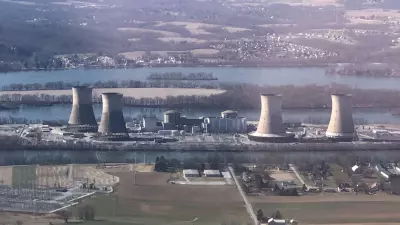Regular energy consumers, not corporations, will bear the brunt of the increased costs of a boom in artificial intelligence that has contributed to a growth in data centers and a surge in power usage, recent research suggests.

Between 2024 and 2025, data center power usage accounted for $9 billion, or 174%, of increased power costs, a June report by Monitoring Analytics, an external market monitor for PJM Interconnection, found. PJM manages the electrical power grid and wholesale electric market for 13 states and Washington, D.C., and this spring, customers were told to expect roughly a $25 increase on their monthly electric bill starting June 1.
“The growth in data center load and the expected future growth in data center load are unique and unprecedented and uncertain and require a different approach than simply asserting that it is just supply and demand,” Monitoring Analytics’ report said.
Data centers house the physical infrastructure to power most of the computing we do today, but many AI models and the large AI companies that power them, like Amazon, Meta and Microsoft use vastly more energy than other kinds of computing. Training a single chatbot like ChatGPT uses about the same amount of energy as 100 homes over the course of a year, an AI founder told States Newsroom earlier this year.
The growth of data centers — and how much power they use — came on fast. A 2024 report by the Joint Legislative Audit and Review Commission in Virginia — known as a global hub for data centers — found that PJM forecasts it will use double the amount of average monthly energy in 2033 as it did in 2023. Without new data centers, energy use would only grow 15% by 2040, the report said.
As of July, the United States is home to more than 3,800 data centers, up from more than 3,600 in April. A majority of data centers are connected to the same electrical grids that power residential homes, commercial buildings and other structures.
“There are locational price differences, but data centers added anywhere in PJM have an effect on prices everywhere in PJM,” Joseph Bowring, president of Monitoring Analytics said.
Creeping costs
At least 36 states, both conservative and liberal, offer tax incentives to companies planning on building data centers in their states. But the increased costs that customers are experiencing have made some wonder if the projects are the economic wins they were touted as.
“I’m not convinced that boosting data centers, from a state policy perspective, is actually worth it,” said New Jersey State Sen. Andrew Zwicker, a Democrat and co-sponsor of a bill to separate data centers from regular power supply. “It doesn’t pay for a lot of permanent jobs.”
Energy cost has historically followed a socialized model, based on the idea that everyone benefits from reliable electricity, said Ari Peskoe, the director of the Electricity Law Initiative at the Harvard Law School Environmental and Energy Law Program. Although some of the pricing model is based on your actual use, some costs like new power generation, transmission and infrastructure projects are spread across all customers.
Data centers’ rapid growth is “breaking” this tradition behind utility rates.
“These are cities, these data centers, in terms of how much electricity they use,” Peskoe said. “And it happens to be that these are the world’s wealthiest corporations behind these data centers, and it’s not clear how much local communities actually benefit from these data centers. Is there any justification for forcing everyone to pay for their energy use?”
This spring in Virginia, Dominion Energy filed a request with the State Corporation Commission to increase the rates it charges by an additional $10.50 on the monthly bill of an average resident and another $10.92 per month to pay for higher fuel costs, the Virginia Mercury reported.
Dominion, and another local supplier, recently filed a proposal to separate data centers into their own rate class to protect other customers, but the additional charges demonstrate the price increases that current contracts could pass on to customers.
In June, the Federal Energy Regulatory Commission convened a technical conference to assess the adequacy of PJM’s resources and those of other major power suppliers, like Midcontinent Independent System Operator, Inc., ISO New England Inc., New York Independent System Operator, Inc., California Independent System Operator Corporation (CAISO) and Southwest Power Pool (SPP).
The current supply of power by PJM is not adequate to meet the current and future demand from large data center loads, Monitoring Analytics asserts in a report following the conference.
“Customers are already bearing billions of dollars in higher costs as a direct result of existing and forecast data center load,” the report said.
Proposed changes
One of the often-proposed solutions to soften the increased cost of data centers is to require them to bring their own generation, meaning they’d contract with a developer to build a power plant that would be big enough to meet their own demand. Though there are other options, like co-location, which means putting some of the electrical demand on an outside source, total separation is the foremost solution Bowring presents in his reports.
“Data centers are unique in terms of their growth and impact on the grid, unique in the history of the grid, and therefore, we think that’s why we think data centers should be treated as a separate class,” Bowring said.
Some data centers are already voluntarily doing this. Constellation Energy, the owner of Three Mile Island nuclear plant in central Pennsylvania, struck a $16 billion deal with Microsoft to power the tech giant’s AI energy demand needs.
But in some states, legislators are seeking to find a more binding solution.
New Jersey Sen. Bob Smith, a Democrat who chairs the Environment and Energy Committee, authored a bill this spring that would require new AI data centers in the state to supply their power from new, clean energy sources, if other states in the region enact similar measures.
“Seeing the large multinational trillion dollar companies, like Microsoft and Meta, be willing to do things like restart Three Mile Island is crazy, but shows you their desperation,” said co-sponsor Zwicker. “And so, okay, you want to come to New Jersey? Great, but you’re not going to put the basis (of the extra cost) on ratepayers.”
New Jersey House members launched a probe into PJM’s practices as the state buys its annual utilities from the supplier at auction this month. Its July 2024 auction saw electrical costs increase by more than 800%, which contributed to the skyrocketing bills that took effect June 1.
Residents are feeling it, Smith said, and he and his co-sponsors plan to use the summer to talk to the other states within PJM’s regional transmission organization (RTO).
“Everything we’re detecting so far is they’re just as angry — the other 13 entities in PJM — as us,” Smith told States Newsroom.
Smith said they’re discussing the possibility of joining or forming a different RTO.
“We’re in the shock and horror stage where these new prices are being included in these bills, and citizens are screaming in pain,” Smith said. “A solution that I filed in the bill, is the one that says, ‘AI data centers, you’re welcome in New Jersey, but bring your own clean electricity with them so they don’t impact the ratepayers.”
Utah enacted a law this year that allows “large load” customers like data centers to craft separate contracts with utilities, and a bill in Oregon, which would create a separate customer class for data centers, called the POWER Act, passed through both chambers last month.
If passed, New Jersey’s law would join others across the country in redefining the relationship between data centers powering AI and utilities providers.
“We have to take action, and I think we have to be pretty thoughtful about this, and look at the big picture as well,” Zwicker said. ”I’m not anti-data center, I’m pro-technology, but I’m just not willing to put it on the backs of ratepayers.”







